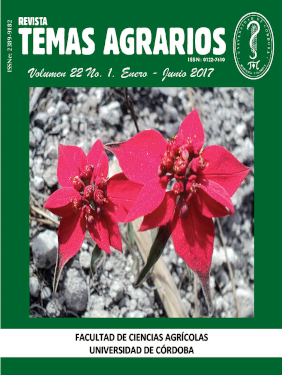Practices used by pesticides fumigators from the middle and low Sinú department of Córdoba
Prácticas empleadas por fumigadores de plaguicidas del medio y bajo Sinú departamento de Córdoba
How to Cite
Amador, C., Luna Rondón, J. M., & Puello Alcocer, E. C. (2017). Practices used by pesticides fumigators from the middle and low Sinú department of Córdoba. Sour Topics, 22(1), 29-40. https://doi.org/10.21897/rta.v22i1.913
Dimensions
license

This work is licensed under a Creative Commons Attribution-NonCommercial 4.0 International License.
Show authors biography
Article visits 2031 | PDF visits
Downloads
Download data is not yet available.
- Badii. M, Garza, R., Garza, V. y Landeros, J. 2005. Los indicadores biológicos en la evaluación de la contaminación por agroquímicos en Ecosistemas acuáticos y asociados. CUICYT, 6, 4-20
- Badii, M. y Landeros, J. 2007. Plaguicidas que afectan a la salud humana y la sustentabilidad. CULCyT, 4(19), 21.
- Barba-Ho, y Becerra, D. 2011. Biodegradabilidad y toxicidad de herbicidas utilizados en el cultivo de caña de azúcar. En: Ingeniería de Recursos Naturales y del Ambiente.
- Barreto., G. Pérez De Corcho, O. 1989. Efecto de pesticidas sobre la microflora del suelo. Revista de Producción Animal. CU. Vol.5. Num.1 Fedesarrollo-Iquartil. 2013. Costos de Producción de Doce Productos Agropecuarios. http://www.fedesarrollo.org.co/wp-content/uploads/2013/02/IF-Costos-agropecuarios_FINAL.pdf. Pág. 181
- Cervantes, R. 2010. Plaguicidas en Bolivia: sus implicaciones en la salud, agricultura y medio ambiente. Revista Virtual REDESMA. Vol. 4(1) Pág. 6, (1-12). Disponible en:
- http://www.cebem.org/cmsfiles/articulos/REDESMA_09_art02.pdf Chile.
- División de políticas públicas saludables y promoción. Departamento de Salud Ocupacional. 2014. Protocolo de vigilancia epidemiológica de trabajadores expuestos a plaguicidas. 2014. Pág. 4 Disponible en http://web.minsal.cl/sites/
- default/files/Protocolo_de_Vigilancia_Trabajadores_Expuestos_Plaguicidas.pdf
- Díaz, A. 2011. Efecto citotóxico y genotóxico del glifosato en linfocitos humanos. Universidad Veracruzana. México. Facultad de Biología. Tesis para optar el título de Licenciado en Biología.
- Duran-Nah, J. y Colli-Quintal, J. 2000. Intoxicación aguda por plaguicidas. Salud pública Méx [online], vol.42, n.1, pp. 48-52. ISSN 0036-3634. Federación de Aseguradores Colombianos.
- FASECOLDA. 2013. Estadísticas del ramoenfermedades profesionales 2000-2011 [En línea]. [Consulta 17 febrero 2014] disponible en: http://www.fasecolda. com/index.php/ramos/riesgos-laborales/ estadisticas-del-ramo
- Instituto Colombiano Agropecuario (ICA), Subgerencia de Producción Agrícola, División de insumos agrícolas. Colombia. 2004. Resolución 001973 del 15 de septiembre de 2004 del ICA. 2004. [En línea]. [Consulta 10 noviembre de 2015] disponible en: www.ica.gov.co/getdoc/ b2e5ff99-bd80-45e8.../PLAGUICIDASPROHIBIDOS.aspx
- Kaczewer, J. 2009. Subestimación del impacto de la exposición a agrotóxicos sobre la salud humana. En:http://vozentrerriana. blogspot.com/2009/08/agroquimicospatente-para-matar.html. Publicado septiembre 15 de 2009.
- Marc, J., Mulner-Lorillon, O., Boulben, S., Hureau, D., Durand, G. and Bellé R. 2002. Pesticide Roundup provokes cell division dysfunction at the level of CDK1/ cyclin B activation. Chem Res Toxicol; 15 (3): 326-31.
- Ministerio de Ambiente, Vivienda y Desarrollo Territorial Dirección de Desarrollo Sectorial Sostenible. 2008. Uso aparente de plaguicidas en Colombia durante los años 2004 – 2007. (s.f). Pág. 13-16
- Montoya, R., Pérez, Y. y Vitoria, R. 2007. Métodos y/o prácticas de aplicación de agroquímicos empleadas por los productores agrícolas en el Departamento de Córdoba. En: Memorias XXXVII Congreso Anual Comalfi. Pág. 38
- Organización Panamericana de la Salud, España. Ministerio de Salud. Presidencia de la Nación y Secretaria de Ambiente y Desarrollo Sustentable. 2007. La problemática de los agroquímicos y sus envases, su incidencia en la salud de los trabajadores, la población expuesta y el ambiente. Provincia de Catamarca. Parte 3. Estudio colaborativo multicéntrico. En: https:// www.estrucplan.com.ar/Producciones/ imprimir.asp?IdEntrega=2446
- Ortiz, R., Villadiego, J. y Cardona, C. 2011. Valoración de los impactos ambientales totales generados por el uso de plaguicidas en actividades ganaderas en el municipio de Pamplona -Norte de Santander – Colombia. En: Revista de Didáctica Ambiental Año 7 Nº 10. Diciembre. Pág. 70
- Paganelli, A., Gnazzo, V., Acosta, H., López, S. y Carrasco, A. 2010. Herbicidas a base de glifosato producen efectos teratogénicos en vertebrados al perjudicar la señalización del ácido retinoico. En: Chem Res Toxicol .18; 23 (10): 1586- 1595. doi: 10.1021 / tx1001749. Epub 2010 09 de agosto Pengue, W. 2003. El glifosato y la dominación del ambiente. En: Biodiversidad. Pág. 5-6
- Ramírez, J. y Lacasaña, M. 2001. Plaguicidas: clasificación, uso, toxicología y medición de la exposición. En: ArchPrev Riesgos Labor; 4(2):67-75
- Rivera, C, Pérez, Y. y Vitoria, R. 2007. Agroquímicos con mayor incidencia de uso para el control de arvenses en los principales cultivos del Departamento de Córdoba. En: Memorias XXXVII Congreso Anual Comalfi. Pág. 25 38
- SIVIGILA Grupo Factores de Riesgo Ambiental, Subdirección de Vigilancia en Salud Pública, INS. 2014. En: www. minproteccionsocial.gov.co/.../Boletin_ epidemiologico_Seman.
- Guzmán, C., Villa, H., Calderón A. 2015. Análisis epidemiológico y clínico de intoxicaciones agudas atendidas en Montería, Colombia. En: Rev. Méd. Risaralda 2015; 21 (1): 17-21.
- Williams, G., Kroes, R. and Munro, C. 2000. Safety evaluation and risk assessment of the herbicide Roundup and its active ingredient, glyphosate, for humans. En: Regulatory Toxicology and Pharmacology, 31 (2): págs. 117-165, PMID 10854122.




















